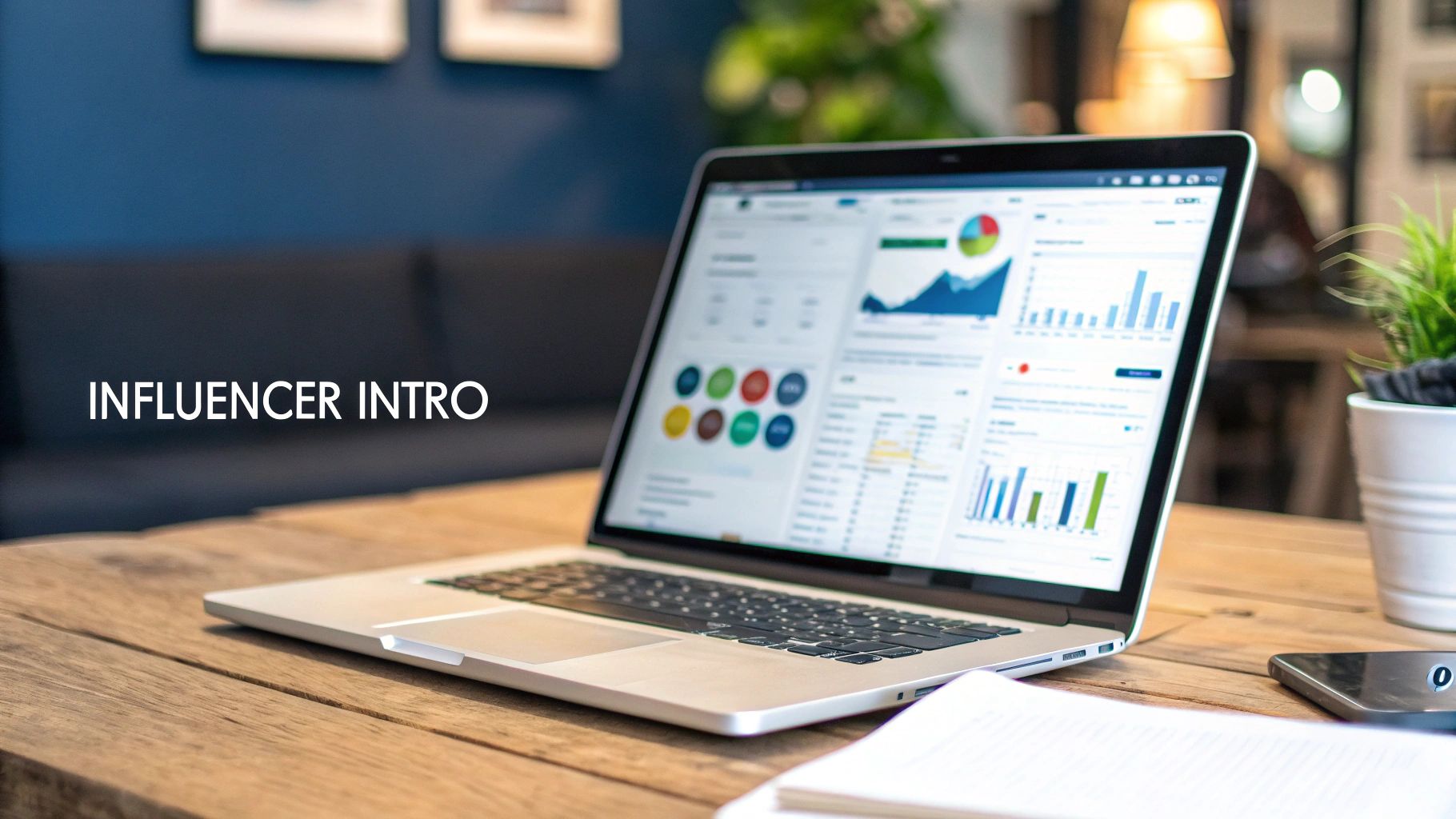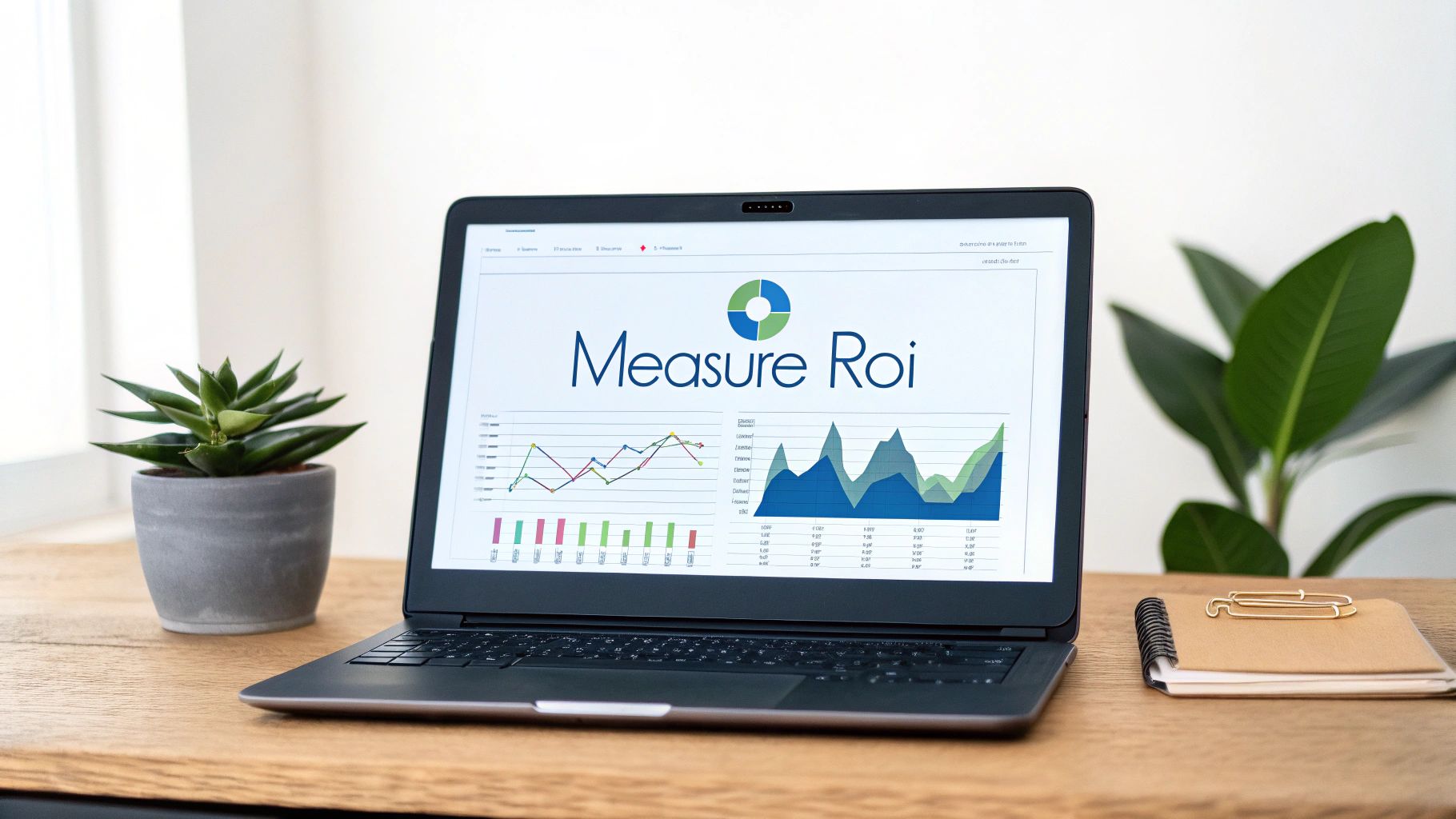Why Influencer Marketing Is Transforming Small Business Growth
Traditional advertising can feel impersonal to today’s consumers. Small businesses are discovering a more effective alternative: influencer marketing. This strategy emphasizes authentic connections with target audiences by partnering with relevant online personalities. This allows businesses to connect with engaged communities, building trust and stimulating growth in ways that traditional paid advertisements often can’t.
The Power of Authentic Connection
Influencer marketing isn’t just about expanding reach; it’s about fostering genuine relationships. Influencers build trust with their followers. When they recommend a product or service, it feels like a personal suggestion, not a commercial. This organic approach can be much more persuasive than traditional advertising, especially for small businesses building their reputation.
For example, imagine a local bakery collaborating with a food blogger known for featuring local businesses. This partnership could significantly boost foot traffic and sales. The influencer’s recommendation holds sway with their loyal followers.
Leveraging Niche Communities
Small businesses have a unique edge in influencer marketing. They can precisely target niche markets by partnering with micro-influencers who have smaller, highly engaged audiences. This creates a stronger connection with the ideal customer. Influencer marketing is increasingly vital for small businesses to boost brand visibility and drive sales. By 2025, 86% of US marketers plan to utilize influencer partnerships, demonstrating the strategy’s growing popularity and effectiveness.
This trend emphasizes how small businesses can use influencers to expand their reach and build credibility. Since influencer marketing cultivates trust with potential customers, it’s understandable that 84% of brands find it effective. The ability to target specific audiences makes influencer marketing a powerful tool for small businesses seeking growth. For more statistics on influencer marketing, visit: SproutSocial.
Agility and Authenticity: A Winning Combination
Small businesses are also inherently agile. They can adapt campaigns and make faster decisions than larger companies, maximizing the impact of influencer collaborations. This flexibility lets them capitalize on current trends and maintain an authentic voice.
Furthermore, small businesses can often build local relationships with influencers. These local partnerships resonate strongly with consumers seeking trustworthy businesses, building brand loyalty and community. This targeted approach fuels sustained growth and helps small businesses secure a solid position in their target markets.
From Transactions to Trust: Building a Loyal Following
Influencer marketing isn’t simply about immediate sales; it’s about cultivating loyal customers. By building trust and engaging with audiences personally, small businesses can create true brand advocates. This shift from transactional marketing to relationship-building is essential for sustainable growth in today’s competitive landscape. This strategy not only increases sales but also enhances brand image, establishing small businesses as valuable community members.
Calculating Real ROI: The Numbers That Actually Matter
Are you a small business owner wondering if influencer marketing is a worthwhile investment? It’s a common question, especially when resources are limited. This section explores the actual ROI small businesses are experiencing from their influencer marketing campaigns. We’ll discuss practical strategies for measuring success and demonstrate how to calculate your return. For further information, feel free to browse our sitemap.
Beyond Vanity Metrics: Measuring What Matters
Many businesses focus on vanity metrics like follower counts and likes. These numbers look impressive, but they don’t provide a complete picture of a campaign’s effectiveness. True ROI comes from understanding the metrics that drive tangible business results.
This means focusing on website traffic, conversions, and sales. These metrics demonstrate how influencer marketing directly impacts your bottom line.
In addition to these key performance indicators, also consider engagement metrics. Comments and shares, for example, reveal how an influencer’s audience interacts with your brand. Analyzing these interactions provides a deeper understanding of your campaign’s performance. This data helps you refine your strategies and optimize your returns.
Calculating Your Influencer Marketing ROI
Calculating the ROI of your influencer marketing campaigns may seem daunting, but it’s a straightforward process. Begin by clearly defining your campaign goals. Are you looking to increase brand awareness, drive website traffic, or generate direct sales?
Once you’ve established your objectives, track the associated costs and the revenue generated by the campaign. For instance, if you invest $500 in an influencer campaign that yields $2,000 in sales, your ROI is 400% (($2,000 – $500) / $500 x 100). This clearly shows the financial impact of influencer marketing for your small business.
The financial benefits extend beyond immediate sales. On average, businesses earn approximately $6.50 for every dollar spent on influencer marketing, with some seeing returns of $20 or more. The average return on Instagram is around $4.12 per dollar invested. This impressive ROI demonstrates the potential of influencer marketing as a cost-effective strategy. For a more detailed look at influencer marketing statistics, check out this resource: Influencer Marketing Statistics.
To further illustrate the potential returns across different platforms, let’s look at the following table:
Influencer Marketing ROI Comparison by Platform
| Platform | Average ROI | Best For Small Business | Typical Investment Range |
|---|---|---|---|
| $4.12 per $1 | Building brand awareness and reaching younger audiences | $100 – $10,000+ | |
| TikTok | Highly variable, potentially very high | Reaching younger audiences and creating viral trends | $50 – $5,000+ |
| Can be lower than other platforms, but still positive | Targeting specific demographics and interests | $250 – $5,000+ | |
| YouTube | Generally high, especially for long-term partnerships | Driving traffic to websites and building strong brand affinity | $500 – $10,000+ |
This table shows how different platforms offer varying ROI potential, and understanding these differences is key to optimizing your influencer marketing spend. While Instagram generally provides a solid return, TikTok offers the potential for viral growth, although results can be less predictable. Facebook, while potentially having a lower ROI, allows for highly targeted campaigns. YouTube, known for building strong brand relationships, often requires a higher investment but can yield significant long-term returns.
Long-Term Value: Building Brand Equity
Beyond immediate sales, influencer marketing contributes significantly to long-term brand building. Partnering with relevant influencers increases brand awareness, builds trust, and fosters customer loyalty. These intangible benefits are challenging to measure but essential for sustainable growth.
Consider a small business that collaborates with a local influencer known for promoting sustainable products. This partnership not only drives immediate sales but also positions the business as environmentally conscious within its community. This alignment builds brand equity and attracts customers who prioritize sustainability. This long-term impact is essential for successful influencer marketing.
From Investment to Impact: Real-World Examples
Many small businesses have seen remarkable results from strategic influencer partnerships. For instance, a local clothing boutique partnered with a fashion micro-influencer and offered a unique discount code to their followers. The boutique saw a 30% increase in sales within one month. Another example is a small restaurant that collaborated with a food blogger. The blogger’s engaging content showcasing the restaurant’s dishes led to a 20% increase in reservations. These examples highlight the tangible benefits of well-executed influencer marketing campaigns for small businesses.
Finding Your Perfect Influencer Match (Without Wasting Time)
The success of your small business influencer marketing depends heavily on choosing the right partners. It’s not about chasing massive follower counts. Instead, focus on finding influencers who genuinely align with your brand and resonate with your specific target audience. This section offers a practical framework for identifying those ideal creators.
Looking Beyond Follower Count: What Really Matters
While a high follower count might seem appealing, it doesn’t guarantee positive results. Micro-influencers, those with smaller but highly engaged audiences, can often deliver better results for small businesses. A recent survey indicated that 44% of brands primarily collaborate with nano-influencers (1,000-10,000 followers), while 25.7% prefer micro-influencers (10,000-100,000 followers). This emphasizes the growing recognition of niche influence. The key metric to focus on is authentic engagement: comments, shares, and genuine interactions that demonstrate a strong connection between the influencer and their followers.
Vetting Potential Partners: A Deeper Dive
Successful small businesses delve deeper than surface-level metrics when assessing potential influencers. They evaluate the quality of engagement, the level of audience trust, and the consistency of the influencer’s content.
- Engagement Quality: Are the comments thoughtful and relevant, or mostly spam? Is there active participation in discussions?
- Audience Trust: Does the influencer maintain a reputation for honesty and transparency? Do their followers value their recommendations?
- Content Consistency: Does the influencer regularly create high-quality content that aligns with your brand values?
These qualitative factors are essential for a successful partnership. This careful approach ensures the influencer’s audience will be receptive to your brand message, increasing the likelihood of a positive campaign outcome.
Reaching Out and Building Relationships
After identifying potential influencers, a personalized approach is crucial for outreach. Avoid generic templates. Instead, take the time to understand the influencer’s work and explain why you believe they would be a good fit for your brand.
- Personalized Outreach: Demonstrate genuine interest in the influencer’s content. Reference specific posts or videos that resonated with you.
- Clear Value Proposition: Clearly outline what you offer the influencer, whether it’s monetary compensation, free products, or increased exposure.
- Collaboration Focus: Approach the partnership as a collaboration, not just a transaction. This fosters mutual respect and builds stronger relationships.
This thoughtful strategy builds a foundation for a mutually beneficial partnership. Building a strong rapport significantly increases the likelihood of a successful and long-lasting collaboration.
Negotiating Authentic Partnerships (Even on a Small Budget)
Even with limited resources, you can negotiate mutually beneficial partnerships. Explore creative compensation models such as product exchanges, experience-based collaborations, or access to exclusive events. Small businesses are successfully leveraging these strategies to build valuable influencer relationships. This demonstrates that influencer marketing is achievable regardless of budget size. By focusing on mutually beneficial arrangements, small businesses can cultivate authentic partnerships that yield tangible results. This win-win approach fosters long-term relationships and maximizes the impact of influencer marketing efforts, ensuring a sustainable and effective strategy that supports business growth.
Why Micro-Influencers Deliver Macro Results for Small Business
While celebrity endorsements retain a certain allure, the real marketing potential for small businesses often lies with micro-influencers. These individuals cultivate smaller, dedicated online communities, offering a unique advantage in the digital sphere. This section explores why micro-influencers often outperform their macro counterparts and even celebrities when it comes to driving conversions and fostering brand loyalty for small businesses.
The Psychology of Trust: Relatability Over Reach
The growing popularity of micro-influencers reflects a change in consumer attitudes. Audiences are becoming increasingly wary of polished, seemingly impersonal celebrity endorsements. They are more inclined to trust recommendations from relatable individuals they perceive as genuine. Micro-influencers, often seen as peers rather than distant figures, cultivate a sense of authenticity.
This genuine connection fosters stronger trust and significantly increases purchase intent. For example, a small skincare brand might partner with a skincare enthusiast with 5,000 engaged followers. This micro-influencer’s authentic product reviews and skincare routines can resonate more deeply with their audience than a generic celebrity endorsement. This targeted approach often leads to higher conversion rates. You can explore our post tag sitemap for more information on related influencer marketing topics.
Targeting Your Niche: Precision Over Popularity
Micro-influencers often focus on specific niches. This concentrated focus enables small businesses to precisely target their desired audience. This precision is essential for maximizing return on investment (ROI), particularly for businesses operating with limited budgets. A targeted approach minimizes wasted ad spend by ensuring your message reaches the most receptive consumers.
Moreover, micro-influencers possess a keen understanding of their audience’s unique needs and preferences. This insight allows them to create content that deeply resonates with their followers, ultimately leading to higher engagement and increased conversions. This close-knit relationship between influencer and audience cultivates a sense of community.
Building Genuine Brand Advocates: Long-Term Value
Micro-influencers can become invaluable brand advocates for small businesses. Their authentic enthusiasm and close relationship with their followers often translate into long-term brand loyalty. This sustained visibility is a significant asset for businesses looking to establish sustainable growth. This organic growth strategy lays a solid foundation for continued success.
Strategies for Successful Micro-Influencer Partnerships
A successful micro-influencer campaign begins with identifying the right partners. Look for creators whose values align with your brand and whose audience matches your target demographic. After identifying potential partners, focus on fostering mutually beneficial relationships.
This necessitates clear communication, respectful collaboration, and fair compensation. To help illustrate the differences between influencer types, let’s take a look at the table below:
To help guide your influencer selection, the following table compares macro and micro-influencers:
Macro vs. Micro-Influencer Comparison for Small Business
Comparative analysis of different influencer tiers and their suitability for small business needs
| Influencer Type | Typical Follower Count | Average Engagement Rate | Cost Range | Best For |
|---|---|---|---|---|
| Micro-Influencer | 1,000 – 100,000 | 2% – 10% | $50 – $500 per post | Niche targeting, building community, high engagement |
| Macro-Influencer | 100,000 – 1 million+ | 1% – 5% | $500 – $10,000+ per post | Broad reach, brand awareness, large-scale campaigns |
This table highlights the key differences between micro and macro-influencers. While macro-influencers offer greater reach, micro-influencers provide higher engagement at a lower cost, making them often ideal for small businesses.
Here are a few key strategies for maximizing the impact of your micro-influencer partnerships:
- Identify and Vet: Thoroughly research potential influencers, paying close attention to the quality of their engagement, audience demographics, and the authenticity of their content.
- Structure Partnerships: Clearly define expectations, deliverables, and compensation from the outset. Explore creative compensation models, such as product exchanges or experience-based collaborations.
- Leverage Authenticity: Empower influencers to create content that aligns with their personal style and resonates with their audience. Avoid overly scripted or inauthentic campaigns.
- Track and Measure: Closely monitor key metrics like website traffic, conversions, and sales to gauge campaign effectiveness and refine future strategies.
By implementing these strategies, small businesses can effectively harness the power of micro-influencers to achieve significant results, often surpassing those of campaigns featuring larger influencers or celebrities. This approach empowers small businesses to compete effectively in the digital marketplace and build enduring relationships with their target audience.
E-Commerce Influencer Strategies That Actually Convert
For e-commerce businesses, influencer marketing isn’t just about vanity metrics like likes and shares. It’s about driving sales. This section explores strategies that effectively convert online traffic into paying customers, particularly for small businesses in the e-commerce space.
Content Formats That Drive Sales
Some content formats consistently outperform others for product-based businesses. Let’s explore some powerful options:
- Unboxing Videos: These videos generate excitement and anticipation for a product, showcasing its features and benefits in a dynamic and engaging way.
- Product Integration in Daily Life: Authentically incorporating products into everyday routines demonstrates practical use and builds relatability with the audience.
- Tutorials and How-Tos: Educational content positions your product as a solution to a specific problem, attracting consumers actively seeking answers and solutions.
- Live Shopping Streams: Interactive live streams foster a sense of urgency and allow for real-time interaction with potential customers.
These formats help potential customers visualize themselves using the product, increasing their desire to purchase. This direct connection between content and conversion is crucial for e-commerce influencer marketing success.
Seamless Paths to Purchase
Creating a smooth path to purchase is essential for converting influencer-driven traffic. This involves the strategic use of affiliate links, discount codes, and shopping integrations.
- Affiliate Links: Unique trackable links enable you to directly attribute sales to specific influencers, providing valuable data for measuring Return on Investment (ROI).
- Discount Codes: Exclusive discounts incentivize purchases and create a sense of exclusivity for the influencer’s audience, encouraging them to buy.
- Shopping Integrations: Tagging products directly within influencer content allows for seamless checkout, minimizing the steps between product discovery and purchase.
This streamlined approach minimizes distractions and encourages impulse buys, effectively turning interested viewers into paying customers. Integrating shopping within the content experience significantly improves conversion rates.
Seasonal Campaigns, Product Launches, and Evergreen Content
Strategically timing influencer campaigns can significantly amplify their impact. Consider these approaches:
- Seasonal Campaigns: Leverage holidays and special occasions to promote relevant products and capitalize on increased consumer spending during these periods.
- Product Launches: Generate buzz and excitement around new product releases by collaborating with influencers for early reviews and exclusive reveals.
- Evergreen Content: Create timeless, valuable content that continues to drive traffic and sales long after its initial publication, providing long-term value and return.
Diversifying your content strategy ensures consistent engagement and targets various customer segments, maximizing reach and impact. This balanced approach maintains momentum and drives sales throughout the year. The growth of e-commerce has strengthened the role of influencer marketing, especially for small online businesses. In fact, 57.6% of brands using influencers are e-commerce stores. Learn more about these influencer marketing statistics.
Measuring the Customer Journey
Tracking the customer journey from initial influencer exposure to final purchase is vital for optimizing your campaigns. Utilize these tools and techniques:
- UTM Parameters: Add tracking codes to your links to measure the source of your website traffic and attribute conversions to specific influencers. This helps understand which influencers are driving the most valuable traffic.
- Platform Analytics: Use built-in analytics dashboards on social media platforms like Facebook and Instagram to track engagement, reach, and website clicks, providing insights into audience behavior.
- E-commerce Platform Data: Analyze sales data within your e-commerce platform, such as Shopify, to identify trends and measure the direct impact of influencer campaigns on revenue.
This comprehensive approach provides valuable data to identify successful strategies and areas for improvement, maximizing ROI and refining your approach. Continuous optimization ensures your influencer marketing campaigns are both effective and efficient.
Building Long-Term Partnerships on a Shoestring Budget
The most valuable influencer relationships go beyond one-off promotions. Cultivating long-term partnerships should be a primary goal for small businesses using influencer marketing. This section explains how resource-conscious businesses create these lasting partnerships without breaking the bank.
Creative Compensation: Thinking Beyond Cash
Many small businesses assume influencer marketing requires a large budget. However, several creative compensation models can be just as effective, or even more so, than cash payments.
- Product Exchange: Offering free products or services in exchange for promotion is a mutually beneficial arrangement, especially for product-based businesses. This allows influencers to experience your offerings firsthand, leading to more authentic and engaging content.
- Experience-Based Partnerships: Providing exclusive experiences, like behind-the-scenes access or invitations to special events, can be very attractive to influencers. These opportunities create memorable content and forge stronger brand connections.
- Mutual Growth Arrangements: Collaborate on cross-promotional activities that benefit both you and the influencer. For example, featuring the influencer on your company’s social media channels while they promote your brand to their followers. This synergistic approach expands reach for everyone.
These alternative compensation models allow small businesses to build strong influencer relationships even with limited budgets. This approach prioritizes value exchange and fosters genuine connections. You might be interested in: How to master influencer marketing on a budget.
Structuring Agreements for Long-Term Value
When creating agreements, structure them to increase in value as the partnership develops. Start with smaller collaborations and gradually expand the scope as the relationship proves successful. This incremental approach builds trust and encourages long-term commitment.
- Tiered Agreements: Offer increasing benefits as the partnership progresses. This could include higher compensation, more exclusive experiences, or greater creative freedom for the influencer. This structure incentivizes continued collaboration and rewards loyalty.
- Performance-Based Bonuses: Tie additional compensation to specific campaign goals, such as increased website traffic or sales generated. This motivates influencers to actively contribute to your business objectives and provides measurable results.
This structured approach ensures a sustainable partnership that benefits both parties, fostering long-term growth and laying the foundation for a mutually beneficial and enduring relationship.
Communication and Creative Freedom: Keys to Authentic Content
Open communication and respecting the influencer’s creative process are essential for long-term success. Provide clear guidelines but allow flexibility in content creation. This empowerment results in more authentic and engaging content.
- Regular Check-ins: Schedule regular communication to discuss campaign progress, offer feedback, and address any questions or concerns. This open dialogue fosters a strong working relationship.
- Creative Briefings: Provide detailed briefings outlining your campaign goals and key messages, but avoid overly strict scripting. Trust the influencer’s expertise in creating content that resonates with their audience.
This collaborative approach empowers influencers to produce their best work while maintaining brand consistency, leading to a mutually beneficial and successful partnership that maximizes the impact of your influencer marketing efforts and fosters long-term growth.
Managing Relationships Efficiently
Managing multiple influencer relationships can demand a lot of time. However, several strategies can streamline the process, even without a dedicated team.
- Centralized Communication: Use a single platform, such as email or a project management tool, to manage all influencer communication. This keeps conversations organized and easy to access.
- Templated Materials: Create templates for outreach, agreements, and reporting to save time and ensure consistency. This simplifies administrative tasks and lets you focus on building relationships.
These straightforward techniques enable small businesses to manage influencer partnerships efficiently, maximizing impact and promoting long-term growth without feeling overwhelmed. This organized approach maximizes the return on your influencer marketing investment and facilitates sustainable success.
Measuring Success and Scaling Your Influencer Program
After launching your influencer marketing campaigns, the next critical step for small businesses is measuring their success and scaling the program for continued growth. This means looking beyond superficial metrics like likes and follower counts and focusing on data that truly reflects business impact.
Key Performance Indicators (KPIs) for Influencer Marketing
To accurately assess your influencer marketing Return on Investment (ROI), you need to track relevant Key Performance Indicators (KPIs). These metrics provide a clear picture of how your campaigns contribute to your business goals. Some essential KPIs include:
- Website Traffic: Monitor the increase in website visits from influencer posts. This shows how effectively influencers drive potential customers to your site.
- Conversions: Track actions taken by visitors from influencer campaigns, such as newsletter sign-ups, resource downloads, or purchases.
- Sales: Measure the direct sales generated through influencer promotions, particularly if using trackable links or discount codes. This data reveals the tangible financial impact of your campaigns.
- Brand Awareness: While more challenging to quantify, assess brand mentions and social media sentiment. These indicate whether the campaign is increasing brand visibility and how consumers perceive your business.
These KPIs offer a comprehensive view of your campaign’s performance. This data-driven approach enables informed decisions and optimizes future strategies for maximum impact.
Calculating ROI and Refining Your Approach
By comparing the cost of your influencer marketing campaigns with the resulting sales and conversions, you can calculate your ROI. This calculation helps determine the most effective campaigns and allocate resources accordingly. Analyzing campaign data also allows you to identify areas for improvement and refine strategies over time.
For example, if a campaign with a micro-influencer generates a significantly higher ROI than one with a macro-influencer, this suggests allocating a larger portion of your budget to micro-influencer partnerships in future campaigns. This data-driven optimization is key to maximizing your influencer marketing ROI.
Scaling Your Influencer Program: Strategic Growth
As your business grows, scaling your influencer program is essential for maintaining momentum. This involves expanding your network of influencers, incorporating learnings from past campaigns, and exploring new strategies.
- Expanding Your Network: Identify new influencers aligned with your brand and target audience. Look for creators with unique perspectives who reach different market segments. This expansion broadens your reach and amplifies your message.
- Leveraging Past Successes: Analyze data from previous campaigns to identify what worked best. Replicate successful strategies and avoid less effective approaches. This iterative approach continually improves campaign performance.
- Testing New Approaches: As the influencer marketing landscape changes, stay open to experimenting with new platforms, content formats, and collaboration models. This experimentation helps you stay ahead of the curve and discover innovative ways to engage your target audience.
By systematically tracking results, analyzing data, and strategically expanding your influencer network, you can transform your program into a powerful engine for sustainable business growth. This long-term approach ensures influencer marketing remains a valuable asset for your small business.
Streamlining Your Influencer Program with REACH Influencers
Managing and scaling influencer marketing campaigns can be challenging. REACH Influencers simplifies this process, providing small businesses with the tools to connect with relevant influencers, manage campaigns efficiently, and track results effectively. The platform streamlines everything from initial outreach to payment processing within an intuitive interface. Learn more about how REACH Influencers can help your small business thrive.






